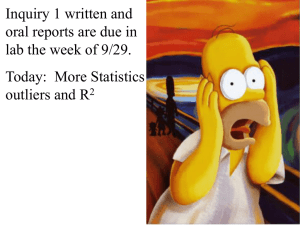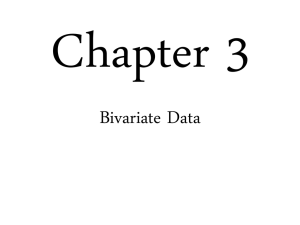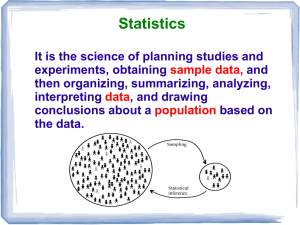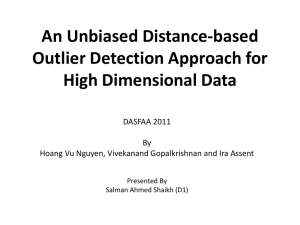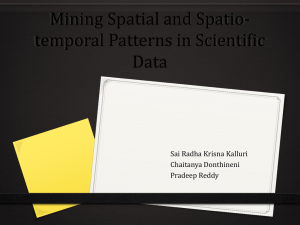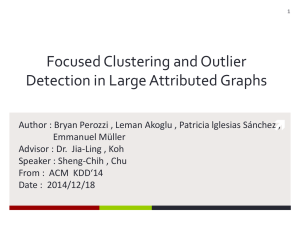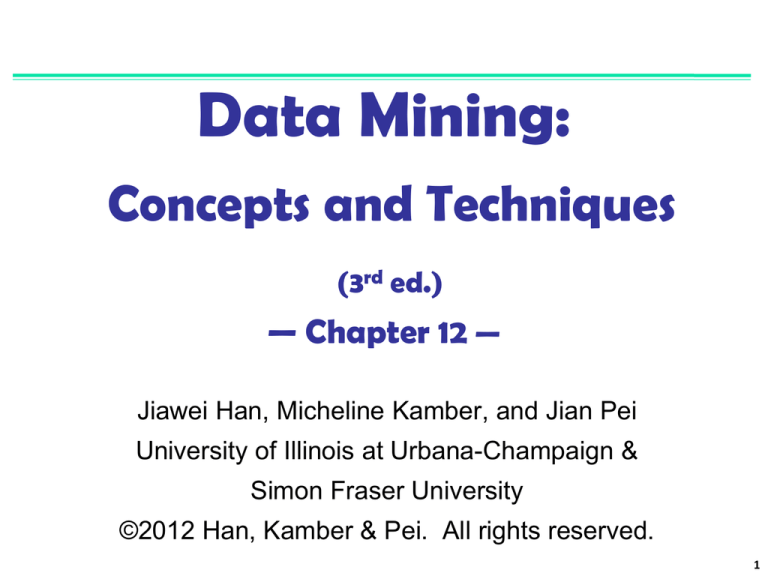
Data Mining:
Concepts and Techniques
(3rd ed.)
— Chapter 12 —
Jiawei Han, Micheline Kamber, and Jian Pei
University of Illinois at Urbana-Champaign &
Simon Fraser University
©2012 Han, Kamber & Pei. All rights reserved.
1
Chapter 12. Outlier Analysis
Outlier and Outlier Analysis
Outlier Detection Methods
Supervised Methods
Unsupervised Methods
Semi-supervised methods
Statistical Approaches
Proximity-Based Approaches
Summary
2
What Are Outliers?
Outlier: A data object that deviates significantly from the normal
objects as if it were generated by a different mechanism
Ex.: Unusual credit card purchase
Outliers are different from the noise data
Noise is random error or variance in a measured variable
Noise should be removed before outlier detection
3
Types of Outliers (I)
Three kinds: global, contextual and collective outliers
Global Outlier
Global outlier (or point anomaly)
Object is Og if it significantly deviates from the rest of the data set
Ex. Intrusion detection in computer networks
Issue: Find an appropriate measurement of deviation
Contextual outlier (or conditional outlier)
Object is Oc if it deviates significantly based on a selected context
o
Ex. 80 F in NYC: outlier? (depending on summer or winter?)
Attributes of data objects should be divided into two groups
Contextual attributes: defines the context, e.g., time & location
Behavioral attributes: characteristics of the object, used in outlier
evaluation, e.g., temperature, pressure, humidity
Issue: How to define or formulate meaningful context?
4
Types of Outliers (II)
Collective Outliers
A subset of data objects collectively deviate
significantly from the whole data set, even if the
individual data objects may not be outliers
Applications: E.g., intrusion detection:
Collective Outlier
When a number of computers keep sending
denial-of-service packages to each other
Detection of collective outliers
Consider not only behavior of individual objects, but also that of
groups of objects
Need to have the background knowledge on the relationship
among data objects, such as a distance or similarity measure
on objects.
5
Challenges of Outlier Detection
Modeling normal objects and outliers properly
Hard to enumerate all possible normal behaviors in an application
The border between normal and outlier objects is often a gray area
Application-specific outlier detection
Choice of distance measure among objects and the model of
relationship among objects are often application-dependent
E.g., clinic data: a small deviation could be an outlier; while in
marketing analysis, larger fluctuations
Handling noise in outlier detection
Noise may distort the normal objects and blur the distinction
between normal objects and outliers. It may help hide outliers and
reduce the effectiveness of outlier detection
Understandability
Understand why these are outliers: Justification of the detection
6
Chapter 12. Outlier Analysis
Outlier and Outlier Analysis
Outlier Detection Methods
Supervised Methods
Unsupervised Methods
Semi-supervised methods
Statistical Approaches
Proximity-Based Approaches
Summary
7
Outlier Detection
Two ways to categorize outlier detection methods:
Based on whether user-labeled examples of outliers can be obtained:
Supervised, semi-supervised vs. unsupervised methods
Based on assumptions about normal data and outliers:
Statistical, proximity-based, and clustering-based methods
8
Supervised Methods
Modeling outlier detection as a classification problem
Methods for Learning a classifier for outlier detection effectively:
Model normal objects & report those not matching the model as
outliers, or
Model outliers and treat those not matching the model as normal
Challenges
Imbalanced classes, i.e., outliers are rare
9
Unsupervised Methods
Assume the normal objects are somewhat ``clustered'‘ into multiple
groups, each having some distinct features
An outlier is expected to be far away from any groups of normal objects
Weakness: Cannot detect collective outlier effectively
Normal objects may not share any strong patterns, but the collective
outliers may share high similarity in a small area
10
Semi-Supervised Methods
In many applications, the number of labeled data is often small: Labels
could be on outliers only, normal objects only, or both
If some labeled normal objects are available
Use the labeled examples and the proximate unlabeled objects to
train a model for normal objects
Those not fitting the model of normal objects are detected as outliers
11
Statistical Methods
Statistical methods (also known as model-based methods) assume
that the normal data follow some statistical model
The data not following the model are outliers.
12
Statistical Methods – Using Maximum
Likelihood
Ex: Avg. temp.: {24.0, 28.9, 28.9, 29.0, 29.1, 29.1, 29.2, 29.2, 29.3, 29.4}
Use the maximum likelihood method to estimate μ and σ
For the above data with n = 10, we have
Consider the value 24
28.61 – 3*1.51 = 24.08
So, 24 is an outlier
13
Statistical Methods – Box Plot
Values less than Q1-1.5*IQR and greater than Q3+1.5*IQR are outliers
Consider the following dataset:
10.2, 14.1, 14.4. 14.4, 14.4, 14.5, 14.5, 14.6, 14.7, 14.7, 14.7, 14.9,
15.1, 15.9, 16.4
Here,
Q2(median) = 14.6
Q1 = 14.4
Q3 = 14.9
IQR = Q3 – Q1 = 14.9 - 14.4 = 0.5
Outliers will be any points:
below Q1 – 1.5×IQR = 14.4 – 0.75 = 13.65 or
above Q3 + 1.5×IQR = 14.9 + 0.75 = 15.65
So, the outliers are at 10.2, 15.9, and 16.4.
14
Statistical Methods – Using Histogram
Figure shows the histogram of purchase amounts in transactions
A transaction in the amount of $7,500 is an outlier, since only 0.2%
transactions have an amount higher than $5,000
Problem: Hard to choose an appropriate bin size for histogram
Too small bin size → normal objects in empty/rare bins, false positive
Too big bin size → outliers in some frequent bins, false negative
15
Statistical Methods – Other Methods
Grubbs test
Mahalaobis distance
Chi Square test
16
Proximity-Based Methods
An object is an outlier if the nearest neighbors of the object are far
away, i.e., the proximity of the object significantly deviates from the
proximity of most of the other objects in the same data set
Example (right figure): Model the proximity of an
object using its 3 nearest neighbors
Objects in region R are substantially different
from other objects in the data set.
Thus the objects in R are outliers
17
Chapter 12. Outlier Analysis
Outlier and Outlier Analysis
Outlier Detection Methods
Supervised Methods
Unsupervised Methods
Semi-supervised methods
Statistical Approaches
Proximity-Based Approaches
Summary
18
Summary
Types of outliers
global, contextual & collective outliers
Outlier detection
supervised, semi-supervised, or unsupervised
Statistical (or model-based) approaches
Proximity-base approaches
19




